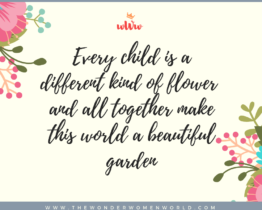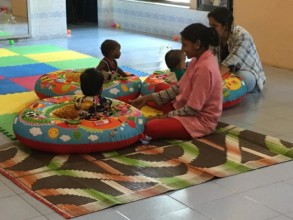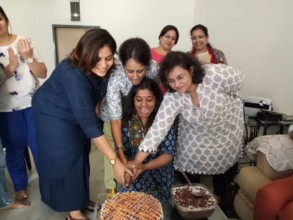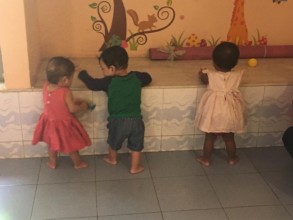JAADU KI JHAPPI

It all began with a short video that was circulating on Facebook – and a series of personal parenting experiences within our own homes which brought together a dormant WhatsApp group, formed somewhere toward the close of 2012, to life! Not to mention an “I need to urgently consult with you all!” request posted by one of our WhatsApp group members (which incidentally totaled 4!)
The seed for Jaadu ki Jhappi germinated at this meet-up, circa September 2017, and it was essentially this – could we, as a group, get together a batch of women, known closely enough and those whom we could personally vouch for – to give cuddles to little babies. It was just as simple as it sounded.

This would be at a children’s home in Navi Mumbai – to enable infants and toddlers to feel the warmth and human touch on a one on one basis for a few hours in a day – every day. No strings attached, just pure unadulterated love such as a parent has for a child – in this case, infants and toddlers who came into the home due to various circumstances and would go to families where they would find the love and care to grow up to be fine young individuals
It was surprising how many responses we got from all the women we contacted – which really thrilled us. There were no academic qualifications needed for this work, and no preparation. All that they needed to do was to be able to give time, on a regular basis, during the week – essentially 2 hours, twice a week, on days of their choice. This was getting more and more exciting for us and something we needed to plan the logistics for as well as ensure that 4 days of a week were evenly covered by the Jaadu ki Jhappi volunteers (as we now called them). We – Aruna Anand, Mahrukh Bandorawala, Barkha Punjabi and Asha Iyer – rolled out the movement on November 14, 2017 with our first batch of 17 volunteers.

At this point, we would like to state that the home where we planned to initiate our Jaadu ki Jhappiyaan left no stone un-turned for the care of these babies, there is only so much that a caregiver can provide – in the midst of feeding, bathing, changing, medicating (if the baby was unwell) and making infants to sleep, in a ratio of 2:10. Which is why we wished to step in as a group of volunteers and help bridge the cuddling gap.
Research
The stark institutional isolation prevalent in adoption homes/ orphanages of some countries might have mostly melted away decades ago, but many babies and young children all over the world still grow up in environments where touch and emotional engagement are lacking. Many children who have not had ample physical and emotional attention are at higher risk for behavioral, emotional and social problems as they grow up.
These trends point to the lasting effects of early infancy environments and the changes that the brain undergoes during that period. Below the surface, some children from deprived surroundings such as orphanages, have vastly different hormone levels than their parent-raised peers even beyond the baby years. For instance, in Romania in the 1980s, by ages 6 to 12, levels of the stress hormone cortisol were still much higher in children who had lived in orphanages for more than eight months than in those who were adopted at, or before, the age of four months, according to a study from Development and Psychopathology. Other work has shown that children who experienced early deprivation also had different levels of oxytocin and vasopressin (hormones that have been linked to emotion and social bonding), despite having had an average of three years in a family home. “This environmental change [into a home] does not seem to have completely overridden all of the effects of early neglect,” the researchers, led by Alison Wismer Fries of the Department of Psychology at the University of Wisconsin–Madison noted in their study, published in 2005 in the Proceedings of the National Academy of Sciences.
Touch underpins our social world and, evidence suggests, it may even help to reduce anxiety and provide pain relief. But can touch shape the actual organization of our brains? Research is now revealing that experiences with touch – especially in infancy – do indeed shape brain development.
This was recently demonstrated by a team of researchers, led by Nathalie Maitre, at the Nationwide Children’s Hospital in Columbus, Ohio. The researchers fitted 125 babies’ heads with electrodes and recorded their brain activity while their skin was lightly touched.
First, they recorded the typical brain response to touch in full-term babies (babies born on or after 37 weeks of pregnancy). They then recorded the brain activity of babies born prematurely (before 37 weeks). Premature and full-term babies were matched by age.
Compared with full-term babies, premature babies showed starkly reduced brain activity when they were touched. The researchers also noted a difference in the distribution of electrical activity across the scalp – that is, different parts of the brain became active at different times when they were touched.

The researchers also showed, for the first time, that for premature babies the quality of touch while in hospital after birth (typically around one month) affected the functioning of the babies’ brains. When they tested the premature babies, just before they were discharged from hospital, they found that the more they experienced pleasant, nurturing touch (such as breastfeeding or skin contact) the greater the brain response to touch. Conversely, unpleasant touch, such as skin punctures and tube insertions, were associated with reduced brain activity.
One year later
This November, 2018, our movement completes one year. We divided the year into 3 phases – ranging from duration of 3-4 months and we can successfully count 40 volunteers in all who have been part of the Jaadu ki Jhappi movement through the year. Some of our volunteers were with us for one phase while some were on for at least 3 phases. Many of the children who found families displayed remarkable changes in the time this movement has been on – we got more smiles, more impatience, more carry me ‘demands’!!
The Adoption home too has experienced a great positive change in the children’s responses and we hope, in time, we will be able to hear from the parents of these children about the growing up years of the children we have come into contact with as part of the Jaadu ki Jhappi movement, and to attribute some of that to the cuddles they got from the volunteering group.
The Jaadu ki Jhappi team knows and acknowledges that this wouldn’t have been possible without the support of the Children’s adoption home, and the unstinted support of all its volunteers. We hope, in time, this movement catches steam and is able to reach out to many more babies – a positive step in this day and age where there is so much to worry about.
Disclaimer: The views and opinions expressed in this article are those of the author and do not necessarily reflect the views of The Wonder Women World. If you wish to share your views you can reach us at [email protected] or reach out here CONTACT US
